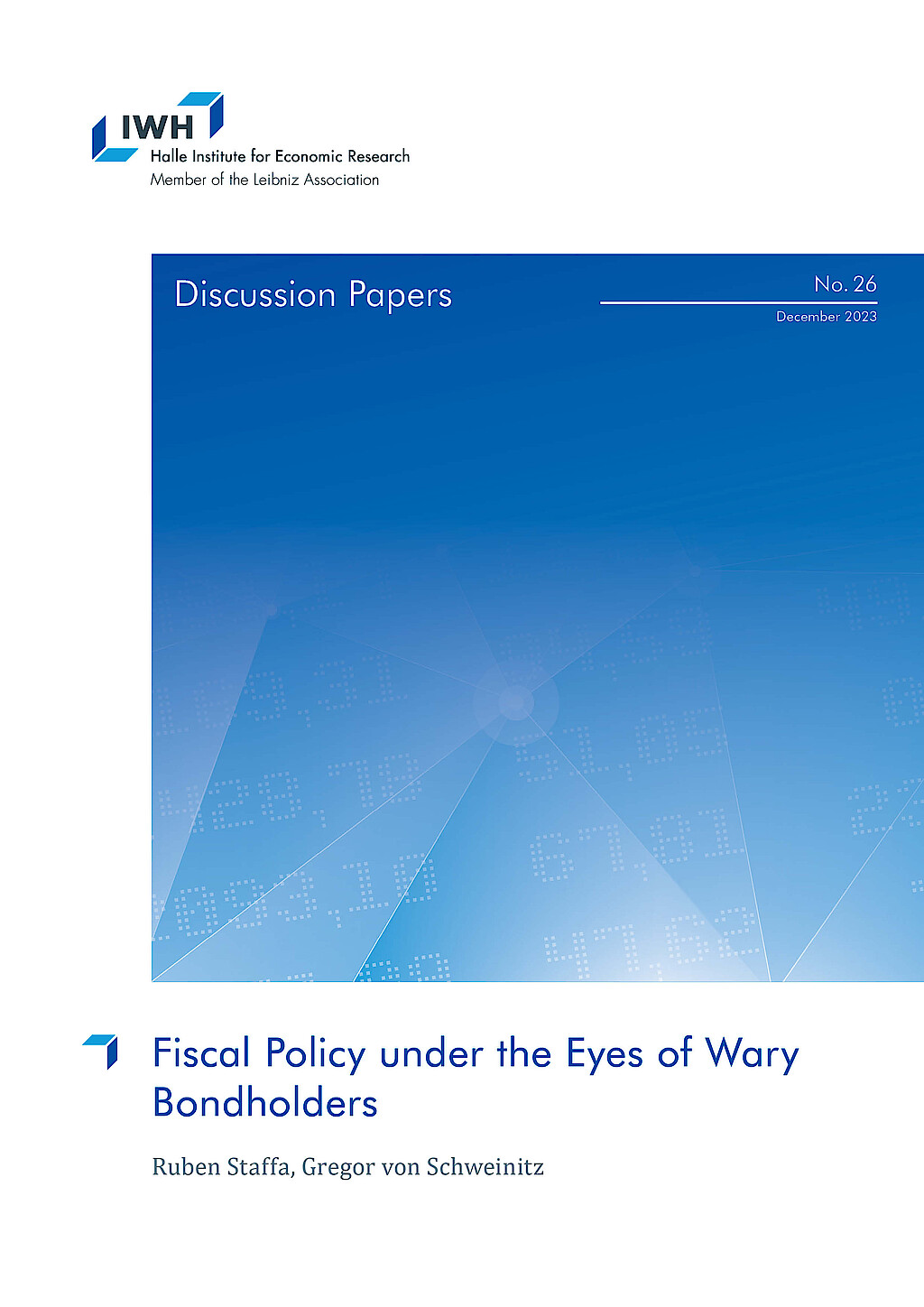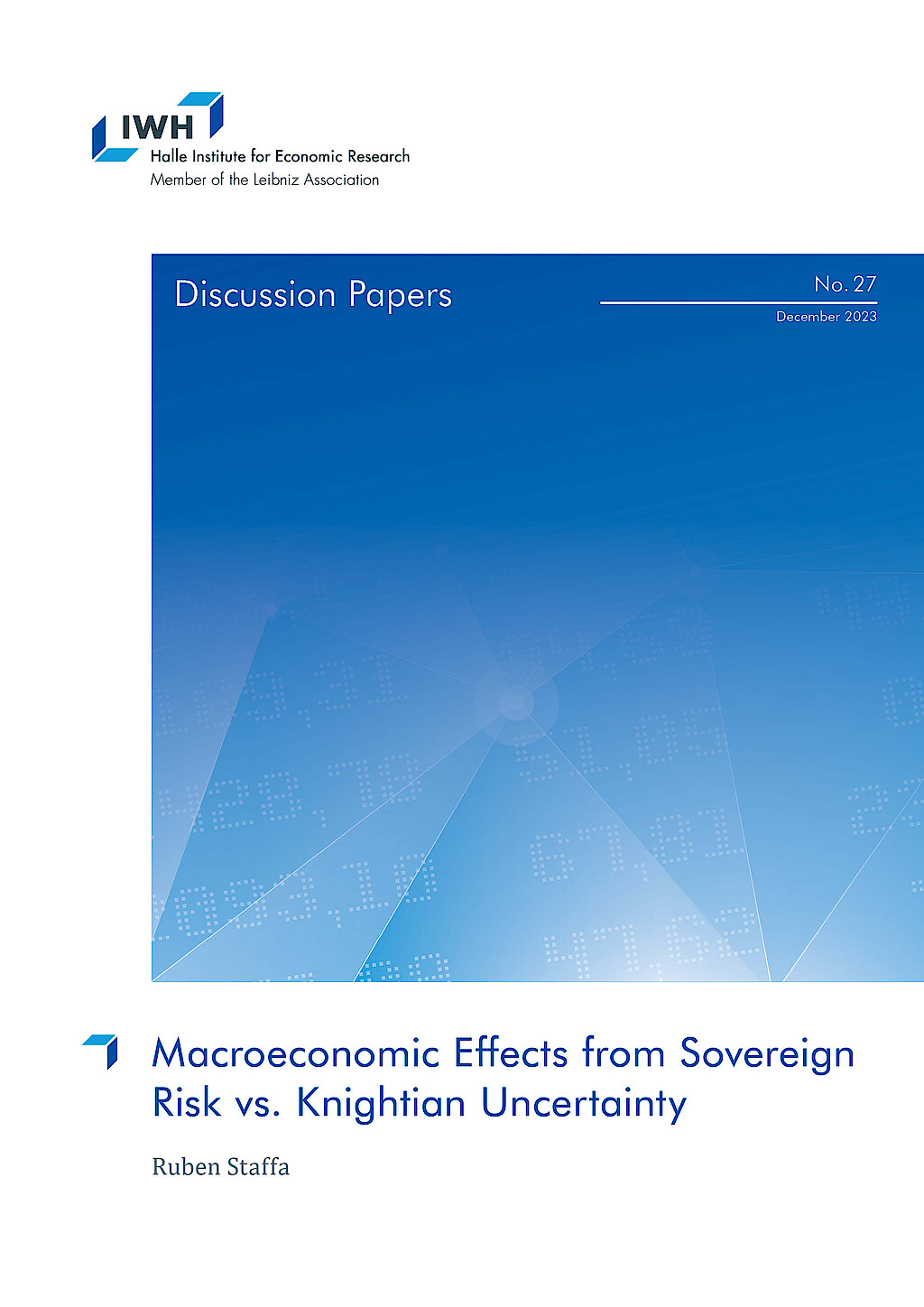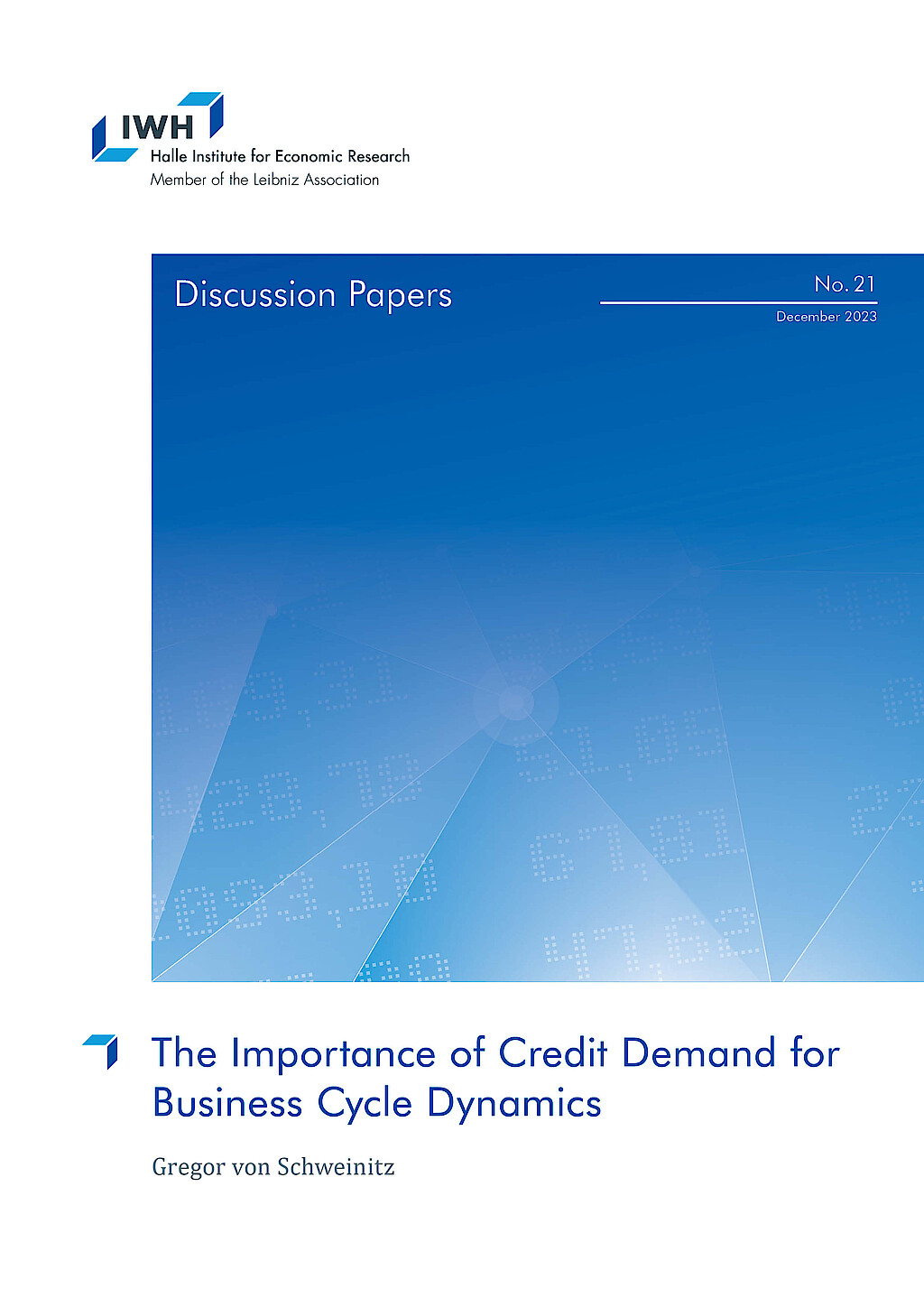Volatility, Growth and Financial Crises
This research group analyses the build-up of financial vulnerabilities and real consequences of financial crises. Different policy shocks and the causal reaction of macroeconomic aggregates are identified. Early-warning models describe the cyclical nature of financial vulnerabilities.
IWH Data Project: Financial Stability Indicators in Europe
Research Cluster
Financial Resilience and RegulationYour contact

- Department Macroeconomics
EXTERNAL FUNDING
01.2022 ‐ 12.2023
Sovereign Risk Shocks
05.2017 ‐ 09.2019
Early Warning Models for Systemic Banking Crises: The Effect of Model and Estimation Uncertainty
01.2018 ‐ 12.2018
International Monetary Policy Transmission
Refereed Publications

Potential Effects of Basel II on the Transmission from Currency Crises to Banking Crises – The Case of South Korea
in: Journal of Money, No. 13, 2010
Abstract
In this paper we evaluate potential effects of the Basel II accord on preventing the transmission from currency crises to banking crises by analyzing the South Korean crisis of 1997. We show that regulatory capital reserves under Basel II would have been lower than those under Basel I, and that therefore Basel II would have had adverse effects on the development of the crisis. Furthermore we investigate whether the behavior of rating agencies has changed since the East Asian crisis. We find no evidence that rating agencies have started to take micro-mismatches into account. Thus, we have reservations concerning the effectiveness of Basel II.

Die Bedeutung der Besitzverflechtung von Kapitalgesellschaften für die Finanzkrise
in: ORDO, 2010
Abstract
Im vorliegenden Papier wird die Bedeutung der Besitzverflechtungen zwischen Aktiengesellschaften (bzw. Kapitalgesellschaften im Allgemeinen) für die gegenwärtige Finanzmarktkrise herausgearbeitet. Durch den wechselseitigen Besitz von Firmen untereinander ist eine Situation entstanden, in denen bestellte Manager sich lediglich kontrollieren. Durch entstehende Abhängigkeiten und die innerhalb der verhältnismäßig kleinen Gruppe von Topmanagern mögliche implizite Koordination konnten Vorstände über die Entlohnungs- und damit auch über die Anreizsysteme, denen sie ausgesetzt sind, wesentlich mitentscheiden. Dies hat, wie gezeigt wird, erheblich zur Entstehung von Anreizsystemen beigetragen, die sich im Kern an kurzfristigen Erfolgen orientieren. Da insbesondere in der Finanzintermediation kurz- und langfristige Gewinnoptimierung durch die starke Korrelation von Risiko und Gewinnmöglichkeiten einem starken Trade- off unterliegen, haben diese Anreizsysteme wiederum eine erhebliche Rolle in der verfehlten Risikopolitik der Banken gespielt, die ein wesentliche Ursache der Krise war.

Finanzielle Instabilität und Krise in den Post-Transformations-Ländern
in: Wirtschaftspolitische Blätter, No. 3, 2009
Abstract
Die Ansteckung durch die globale Finanzkrise war nur ein Auslöser für die schwere Krise in den europäischen Post-Transformations-Ländern. Ursache war die seit 2001 zunehmende finanzielle Instabilität der Länder in Zusammenhang mit der Übernahme ihres Banken- und Finanzsektors durch internationale Finanzinstitutionen. Allgemeine euphorische Renditeerwartungen bildeten den Auftakt für Vermögenspreisblasen und die steigende Verschuldung des privaten Sektors, die durch ausländische Kapitalzuflüsse genährt wurde. Die Studie argumentiert daher, dass simple Konzepte einer Beschränkung inländischer Nachfrage keinen Ausweg aus der Krise weisen. Vielmehr wird eine zweite Transformation notwendig, die ein Wachstumsmodell etabliert, das den Einfluss spekulativer Kapitalzuflüsse reduziert und weiterhin hohe Wachstumsraten ermöglicht.
Working Papers

Risky Oil: It's All in the Tails
in: NBER Working Paper, No. 32524, 2024
Abstract
<p>The substantial fluctuations in oil prices in the wake of the COVID-19 pandemic and the Russian invasion of Ukraine have highlighted the importance of tail events in the global market for crude oil which call for careful risk assessment. In this paper we focus on forecasting tail risks in the oil market by setting up a general empirical framework that allows for flexible predictive distributions of oil prices that can depart from normality. This model, based on Bayesian additive regression trees, remains agnostic on the functional form of the conditional mean relations and assumes that the shocks are driven by a stochastic volatility model. We show that our nonparametric approach improves in terms of tail forecasts upon three competing models: quantile regressions commonly used for studying tail events, the Bayesian VAR with stochastic volatility, and the simple random walk. We illustrate the practical relevance of our new approach by tracking the evolution of predictive densities during three recent economic and geopolitical crisis episodes, by developing consumer and producer distress indices that signal the build-up of upside and downside price risk, and by conducting a risk scenario analysis for 2024.</p>

Fiscal Policy under the Eyes of Wary Bondholders
in: IWH Discussion Papers, No. 26, 2023
Abstract
This paper studies the interaction between fiscal policy and bondholders against the backdrop of high sovereign debt levels. For our analysis, we investigate the case of Italy, a country that has dealt with high public debt levels for a long time, using a Bayesian structural VAR model. We extend a canonical three variable macro mode to include a bond market, consisting of a fiscal rule and a bond demand schedule for long-term government bonds. To identify the model in the presence of political uncertainty and forward-looking investors, we derive an external instrument for bond demand shocks from a novel news ticker data set. Our main results are threefold. First, the interaction between fiscal policy and bondholders’ expectations is critical for the evolution of prices. Fiscal policy reinforces contractionary monetary policy through sustained increases in primary surpluses and investors provide incentives for “passive” fiscal policy. Second, investors’ expectations matter for inflation, and we document a Fisherian response of inflation across all maturities in response to a bond demand shock. Third, domestic politics is critical in the determination of bondholders’ expectations and an increase in the perceived riskiness of sovereign debt increases inflation and thus complicates the task of controlling price growth.

Macroeconomic Effects from Sovereign Risk vs. Knightian Uncertainty
in: IWH Discussion Papers, No. 27, 2023
Abstract
This paper compares macroeconomic effects of Knightian uncertainty and risk using policy shocks for the case of Italy. Drawing on the ambiguity literature, I use changes in the bid-ask spread and mid-price of government bonds as distinct measures for uncertainty and risk. The identification exploits the quasi-pessimistic behavior under ambiguity-aversion and the dealer market structure of government bond markets, where dealers must quote both sides of the market. If uncertainty increases, ambiguity-averse dealers will quasi-pessimistically quote higher ask and lower bid prices – increasing the bid-ask spread. In contrast, a pure change in risk shifts the risk-compensating discount factor which is well approximated by the change in bond mid-prices. I evaluate economic effects of the two measures within an instrumental variable local projection framework. The main findings are threefold. First, the resulting shock time series for uncertainty and risk are uncorrelated with each other at the intraday level, however, upon aggregation to monthly level the measures become correlated. Second, uncertainty is an important driver of economic aggregates. Third, macroeconomic effects of risk and uncertainty are similar, except for the response of prices. While sovereign risk raises inflation, uncertainty suppresses price growth – a result which is in line with increased price rigidity under ambiguity.

The Importance of Credit Demand for Business Cycle Dynamics
in: IWH Discussion Papers, No. 21, 2023
Abstract
This paper contributes to a better understanding of the important role that credit demand plays for credit markets and aggregate macroeconomic developments as both a source and transmitter of economic shocks. I am the first to identify a structural credit demand equation together with credit supply, aggregate supply, demand and monetary policy in a Bayesian structural VAR. The model combines informative priors on structural coefficients and multiple external instruments to achieve identification. In order to improve identification of the credit demand shocks, I construct a new granular instrument from regional mortgage origination. <br />I find that credit demand is quite elastic with respect to contemporaneous macroeconomic conditions, while credit supply is relatively inelastic. I show that credit supply and demand shocks matter for aggregate fluctuations, albeit at different times: credit demand shocks mostly drove the boom prior to the financial crisis, while credit supply shocks were responsible during and after the crisis itself. In an out-of-sample exercise, I find that the Covid pandemic induced a large expansion of credit demand in 2020Q2, which pushed the US economy towards a sustained recovery and helped to avoid a stagflationary scenario in 2022.

Uncovering Disaggregated Oil Market Dynamics: A Full-Information Approach to Granular Instrumental Variables
in: Working Paper, 2023
Abstract
<p>The world price of oil is determined by the interactions of multiple producers and consumers who face different constraints and shocks. We show how this feature of the oil market can be used to estimate local and global elasticities of supply and demand and provide a rich set of testable restrictions. We develop a novel approach to estimation based on full-information maximum likelihood that generalizes the insights from granular instrumental variables. We conclude that the supply responses of Saudi Arabia and adjustments of inventories have historically played a key role in stabilizing the price of oil. We illustrate how our structural model can be used to analyze how individual producers and consumers would dynamically adapt to a geopolitical event such as a major disruption in the supply of oil from Russia.</p>














